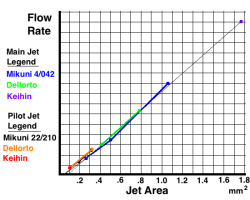jaguar
~SPONSOR~
I've read that there are significant differences between the different brands of jets due to the entry and exit angles for their holes. But when I tested a bunch of main and idle jets for flow rate they all basically were the same, with the flow rate only depending on the hole size (the area to be exact). I tested them using an inverted water bottle filled with premix and determined the flow rate by how much time they took to fill a certain volume. The graph for the idle jets was a bit offset from the main jets.

